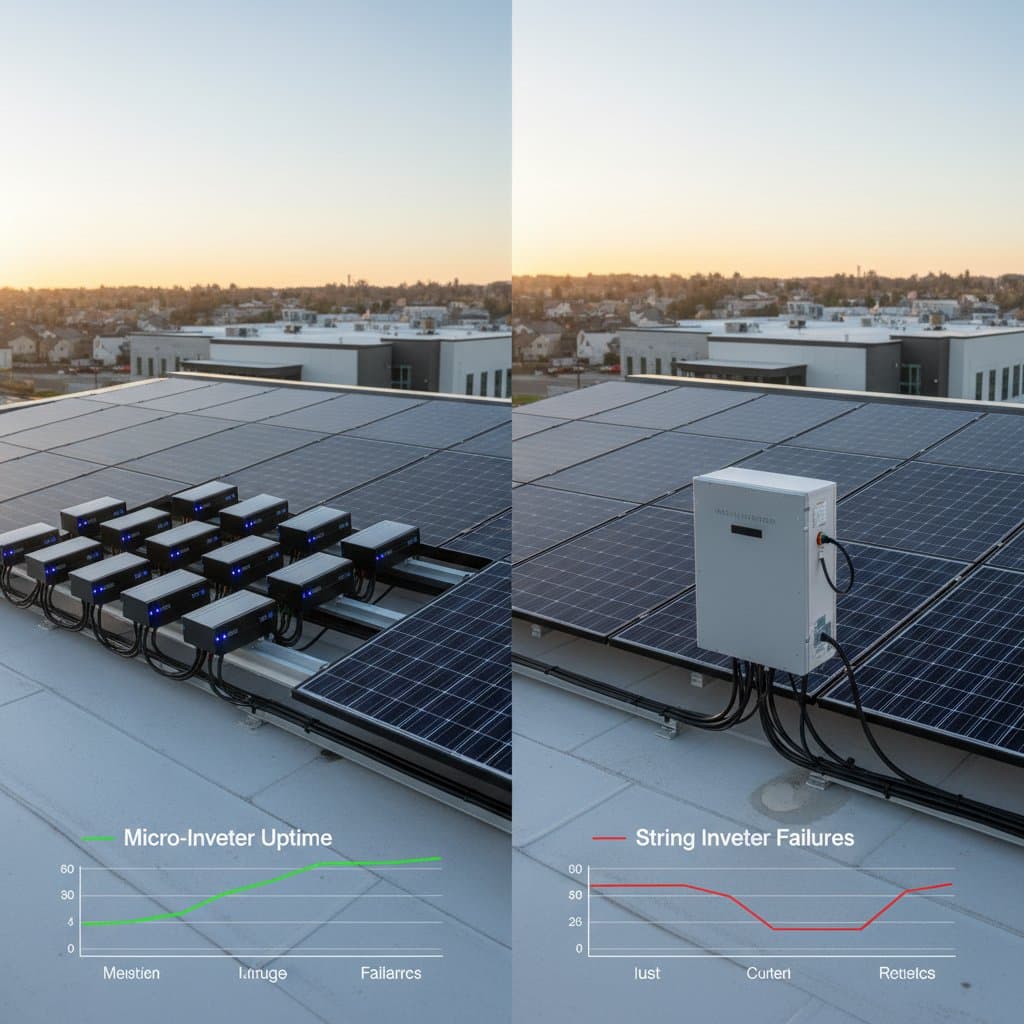2025 Data: Micro-Inverters Edge Out String Inverters in Reliability
Recent performance data highlights a significant advancement in inverter reliability for residential and small commercial solar installations. Micro-inverters now record fewer system faults and higher uptime rates than traditional string inverters. Field studies and manufacturer reports confirm that this distributed technology excels in metrics previously led by string systems.
Installers and asset managers closely monitor these developments, as they shape project designs, maintenance strategies, and overall system value. String inverters maintain a cost edge in some setups, yet micro-inverters provide superior consistency in everyday operations.
Field Data Highlights
Aggregated tracking from distributed solar systems in multiple regions shows micro-inverters achieving average uptime exceeding 99 percent. String inverter systems in comparable setups average slightly less. Failure rates, calculated as downtime events per thousand units, reveal micro-inverters with approximately half the incidents of string counterparts.
Leading manufacturers supplied data from their monitoring platforms, demonstrating reliability across diverse climates and installations. In high-temperature areas, micro-inverter systems exhibit strong heat tolerance and design durability. Long-term programs further show stable performance over time, with lower efficiency degradation than string systems.
Service records from installers support these observations, noting reduced callouts for module-level setups in residential and light commercial applications.
Contributing Factors Behind the Shift
Several design elements drive the enhanced reliability of micro-inverters. The distributed setup avoids reliance on one central unit, which cuts overall downtime during individual failures. Independent module operation prevents fault spread and streamlines troubleshooting.
Effective thermal management plays a crucial role. By spreading heat dissipation across units, micro-inverters lessen stress on components and prolong lifespan. String inverters, however, face quicker wear from concentrated heat, particularly on rooftops with poor ventilation.
Recent component upgrades, including durable capacitors, protective housings, and robust power electronics, bolster stability in harsh environments. Integrated remote monitoring enables swift issue detection and resolution.
Cost and Design Tradeoffs
Reliability advantages do not eliminate cost and design factors in choosing equipment. String inverters provide lower initial expenses and easier setup for large, even arrays. Developers prioritizing upfront savings often select them for efficiency.
When evaluating full lifecycle costs, including warranties and maintenance, micro-inverters gain appeal. Fewer service visits, quicker diagnostics, and rare replacements balance their higher price. Service contract managers document savings in labor and parts over years.
System scale influences decisions. In compact residential setups, module-level simplicity overrides cost. Larger systems favor strings for scalability and unified oversight. Emerging hybrid approaches blend both, applying micro-inverters to key array sections and strings to main generation areas.
Performance Consistency Across Conditions
Reliability encompasses steady energy output in challenging scenarios. Micro-inverters outperform in shaded or misaligned installations, as issues affect only individual panels, not the full string.
This trait suits intricate roof layouts where perfect alignment proves elusive. Installers observe boosted energy harvest and reliable forecasts, aiding customer financial projections.
String systems thrive in even lighting but suffer more from mismatches. Power optimizers help close the difference, though micro-inverters hold clear benefits in variable sites.
Industry Perspectives
Manufacturers expand micro-inverter offerings and extend warranties in response to this data, underscoring faith in durability. Service firms incorporate diagnostics into broad platforms for tracking mixed fleets.
Surveys by trade groups indicate rising customer demand for module-level options, driven by better visibility and isolation. An installation firm leader noted a nearly one-third drop in service calls for micro-inverter projects versus prior string ones.
Utility-scale teams approach cautiously amid device volume challenges, but advanced software sparks interest in distributed setups beyond homes.
Safety and Compliance Considerations
Built-in safety boosts micro-inverter adoption. Many areas mandate rapid shutdown at the module level; micro-inverters comply natively, simplifying designs and setups.
String inverters require extra devices for the same, adding wiring and risks. In regulated markets focused on fire and electrical safety, micro-inverters streamline operations.
Market Implications
This reliability shift will guide future buying decisions. Distributors stock more micro-inverter varieties for retrofits and new projects. Training shifts toward module-level skills in certification programs.
Suppliers see increased need for quality capacitors, sealed enclosures, and smart chips, fueling product evolution and tier distinctions.
Lenders review the data for financing impacts. Dependable inverters enhance project security, potentially easing insurance and reserves. Micro-inverters could yield better terms, aiding small developers.
Aligning Inverter Choices with Project Goals
Designers now weigh evolving reliability when picking technology. Micro-inverters suit those valuing endurance and low upkeep. Installers benefit from fewer interventions, fostering satisfaction and steady workflows.
String inverters persist in large-scale utility and commercial uses for management ease. Mounting evidence positions micro-inverters beyond niches, thanks to monitoring gains and cost refinements.
The data underscores a move to smarter, tougher systems. Inverter choices increasingly emphasize lifecycle dependability, ease, and enduring value. Project teams can apply these insights to align technology with site needs, resources, and goals, securing reliable output and returns.
